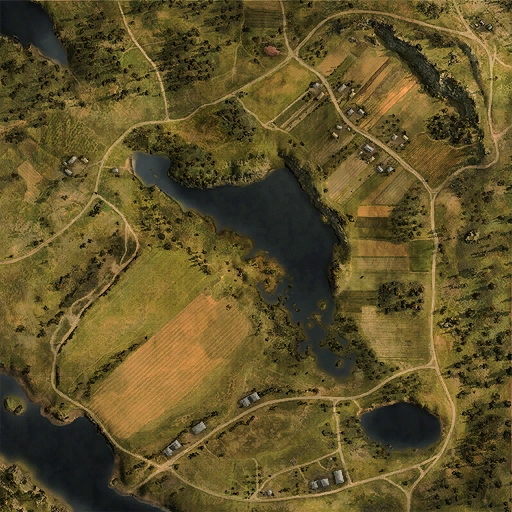Malinovka
Initial staging areas are separated by a wide open field, ideal for artillery and defensive operations. Make use of flanking maneuvers and natural defenses like woods, hills, and farmhouses, as these can be decisive. Another option is a well-coordinated high-speed combined arms attack across the field which could bring victory, but at the risk of a bloody loss.
Colloquially also known as "Campinovka" for the tendency of most players to just sit behind cover on their side of the starting field and snipe each other.
Camo Type: Summer
There are plenty of different theories on how to win this map. The trick to doing well here is team work, regardless of the tactics used. While communication is often difficult in Random Battles, having just a few people talking to each other can turn the tide. Artillery has little to stand in its way if appropriately placed, less the depression on the west spawn and the buildings in the east spawn.
Standard Battle
The map is very wide open, and thus sniping is key. There are two main locations of engagement:
- Across no man's land, between both spawns. This favours sniping.
- The hill and the area below it. This favours flanking and brawling.
At the start of the battle, the first thing to do is to check the number of scouts and SPGs - how many scouts do you have and how many scouts do they have, and are there SPGs to support them? This will decide how the initial strategy plays out.
If you have more scouts than the opponent, send a skilled scout to light up the side of the enemy field, as the distance between the spawns is smaller than the drawing limit. Tank Destroyers and tanks with sniping capability should be prepared to shoot anything that is lit up, and SPGs should be aiming at the enemy standoff line, marked by the line of rocks on one side and the line of houses on the other. SPGs should also report any environmental changes, such as trees falling, to the team. Hopefully, this should result in substantial portions of the enemy team being lit up and damaged. Alternatively, lights can try flanking the enemy position via the hill side, but this may be difficult considering that they will encounter enemy forces heading for the hill. This should only be attempted by skilled drivers with high Camouflage skill. Successful breakthrough, however, will often light up the enemy SPGs, leading to their neutralisation or at least forcing them out of position for some time.
It goes without saying that tanks less suited for sniping should head for the hill, as it is to their advantage.
If your opponents have more scouts, leave a token force to defend, with good shooters who can hit scouts. Otherwise, many tanks can be lost to enemy spotting as the field is still much wider than the average tank's spotting range. Send the full force to the hill for better odds of overwhelming the enemy position.
If there is a lack of scouts, the M18 Hellcat will often suffice when placed in the bushes at the Southwest side of the field. Alternatively, a tougher heavy tank can be placed there, which will draw bounced shots and expose enemies to fire. This works best when there are no enemy SPGs in play.
Mid-battle, the focus shifts to the Hill, where heavy tanks will often brawl with each other at mid-range. This region is often the deciding factor between victory and defeat, and standard brawling tactics apply. Do note, however, that South spawn has access to a Windmill as cover, so the other team will need to push hard to force them out. Bouncier mediums like the T-44 come in handy here, and American heavies should find the terrain ideal for hull-down tactics. The region is exposed to SPG fire, so staying artillery safe is of importance (especially with 8.6 and top tier SPGs).
Below the hill is a wide open area. This is very exposed to both team's forests (and sometimes even their base), so only fast tanks or tanks with very tough fronts should use this area. Mediums can conduct nasty flanking operations here and lights can slip past to the SPGs to eliminate them. This is where heavier tank destroyers like the T28 and AT 15 have a niche as defenders without needing to struggle up the hill and expose their sides.
By end-game, the match should be decided. Field defenders from the winning team should push forward to get themselves some kills. If it goes down to the wire, good brawlers such as the IS-3 will have good chances winning duels with survivors.
All in all, hold the field, take the hill and sweep down for the win.
